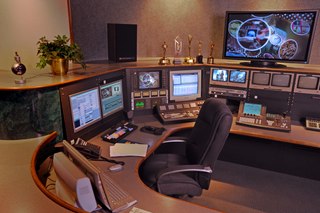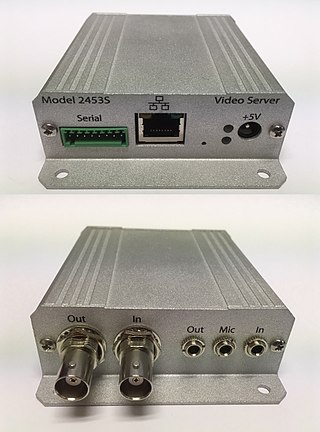A codec is a device or computer program that encodes or decodes a data stream or signal. Codec is a portmanteau of coder/decoder.

Digital video is an electronic representation of moving visual images (video) in the form of encoded digital data. This is in contrast to analog video, which represents moving visual images in the form of analog signals. Digital video comprises a series of digital images displayed in rapid succession, usually at 24 frames per second. Digital video has many advantages such as easy copying, multicasting, sharing and storage.

Video is an electronic medium for the recording, copying, playback, broadcasting, and display of moving visual media. Video was first developed for mechanical television systems, which were quickly replaced by cathode-ray tube (CRT) systems which, in turn, were replaced by flat panel displays of several types.

Video editing software, or a video editor is software used performing the post-production video editing of digital video sequences on a non-linear editing system. It has replaced traditional flatbed celluloid film editing tools and analog video tape editing machines.

Closed captioning (CC) and subtitling are both processes of displaying text on a television, video screen, or other visual display to provide additional or interpretive information. Both are typically used as a transcription of the audio portion of a program as it occurs, sometimes including descriptions of non-speech elements. Other uses have included providing a textual alternative language translation of a presentation's primary audio language that is usually burned-in to the video and unselectable.

Non-linear editing is a form of offline editing for audio, video, and image editing. In offline editing, the original content is not modified in the course of editing. In non-linear editing, edits are specified and modified by specialized software. A pointer-based playlist, effectively an edit decision list (EDL), for video and audio, or a directed acyclic graph for still images, is used to keep track of edits. Each time the edited audio, video, or image is rendered, played back, or accessed, it is reconstructed from the original source and the specified editing steps. Although this process is more computationally intensive than directly modifying the original content, changing the edits themselves can be almost instantaneous, and it prevents further generation loss as the audio, video, or image is edited.

Videotape is magnetic tape used for storing video and usually sound in addition. Information stored can be in the form of either an analog or digital signal. Videotape is used in both video tape recorders (VTRs) and, more commonly, videocassette recorders (VCRs) and camcorders. Videotapes have also been used for storing scientific or medical data, such as the data produced by an electrocardiogram.
An edit decision list or EDL is used in the post-production process of film editing and video editing. The list contains an ordered list of reel and timecode data representing where each video clip can be obtained in order to conform the final cut.

Final Cut Pro is a professional non-linear video-editing application initially developed by Macromedia, and, since 1998, by Apple as part of its pro apps collection. Final Cut Pro allows users to import, edit, and process video footage, and output it to a wide variety of formats.
Digital asset management (DAM) and the implementation of its use as a computer application is required in the collection of digital assets to ensure that the owner, and possibly their delegates, can perform operations on the data files.

A video server is a computer-based device that is dedicated to delivering video. Video servers are used in a number of applications, and often have additional functions and capabilities that address the needs of particular applications. For example, video servers used in security, surveillance and inspection applications typically are designed to capture video from one or more cameras and deliver the video via a computer network. In video production and broadcast applications, a video server may have the ability to record and play recorded video, and to deliver many video streams simultaneously.

Adobe Premiere Pro is a timeline-based and non-linear video editing software application (NLE) developed by Adobe Inc. and published as part of the Adobe Creative Cloud licensing program. First launched in 2003, Adobe Premiere Pro is a successor of Adobe Premiere. It is geared towards professional video editing, while its sibling, Adobe Premiere Elements, targets the consumer market.

Vegas Pro is a video editing software package for non-linear editing (NLE). The first release of Vegas Beta was on June 11, 1999. The software runs on Windows operating systems.
MPEG transport stream or simply transport stream (TS) is a standard digital container format for transmission and storage of audio, video, and Program and System Information Protocol (PSIP) data. It is used in broadcast systems such as DVB, ATSC and IPTV.

Digital cinematography is the process of capturing (recording) a motion picture using digital image sensors rather than through film stock. As digital technology has improved in recent years, this practice has become dominant. Since the mid-2010s, most movies across the world are captured as well as distributed digitally.
The Technology and Engineering Emmy Awards, or Technology and Engineering Emmys, are one of two sets of Emmy Awards that are presented for outstanding achievement in engineering development in the television industry. The Technology and Engineering Emmy Awards are presented by the National Academy of Television Arts and Sciences (NATAS), while the separate Primetime Engineering Emmy Awards are given by its sister organization the Academy of Television Arts & Sciences (ATAS).
QuickTime File Format (QTFF) is a computer file format used natively by the QuickTime framework.
Blackbird is an integrated internet video platform, video editing software, covering non-linear editing and publishing for broadcast, web and mobile.
Ingex is an open-source (GPL) suite of software for the digital capture of audio and video data, without the need for traditional audio or video tape or cassettes. Serial digital interface (SDI) capture is supported, as well as real-time transcoding. Portions of the software suite also act as a network file server for media files, as well as archiving to LTO-3 data tape. Audio and video media files can also be stored on USB hard drives or Network Attached Storage. The software is heavily used by the BBC, and was developed by the BBC Research Laboratory.









